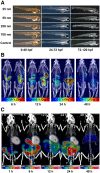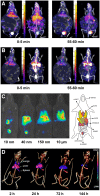Molecular Imaging, Radiochemistry, and Environmental Pollutants
- PMID: 37442598
- PMCID: PMC10394311
- DOI: 10.2967/jnumed.122.265209
Molecular Imaging, Radiochemistry, and Environmental Pollutants
Abstract
The worldwide proliferation of persistent environmental pollutants is accelerating at an alarming rate. Not surprisingly, many of these pollutants pose a risk to human health. In this review, we examine recent literature in which molecular imaging and radiochemistry have been harnessed to study environmental pollutants. Specifically, these techniques offer unique ways to interrogate the pharmacokinetic profiles and bioaccumulation patterns of pollutants at environmentally relevant concentrations, thereby helping to determine their potential health risks.
Keywords: PET imaging; SPECT imaging; environmental pollutants; fluorescence imaging; molecular imaging.
© 2023 by the Society of Nuclear Medicine and Molecular Imaging.
Figures




References
-
- Park JE, Lee JY, Chae J, et al. . In vivo tracking of toxic diesel particulate matter in mice using radiolabeling and nuclear imaging. Chemosphere. 2023;313:137395. - PubMed
-
- Manojkumar Y, Pilli S, Rao PV, Tyagi RD. Sources, occurrence and toxic effects of emerging per- and polyfluoroalkyl substances (PFAS). Neurotoxicol Teratol. 2023;97:107174. - PubMed
-
- Pietroiusti A, Stockmann-Juvala H, Lucaroni F, Savolainen K. Nanomaterial exposure, toxicity, and impact on human health. Wiley Interdiscip Rev Nanomed Nanobiotechnol. 2018;10:e1513. - PubMed
Publication types
MeSH terms
Substances
Grants and funding
LinkOut - more resources
Full Text Sources
